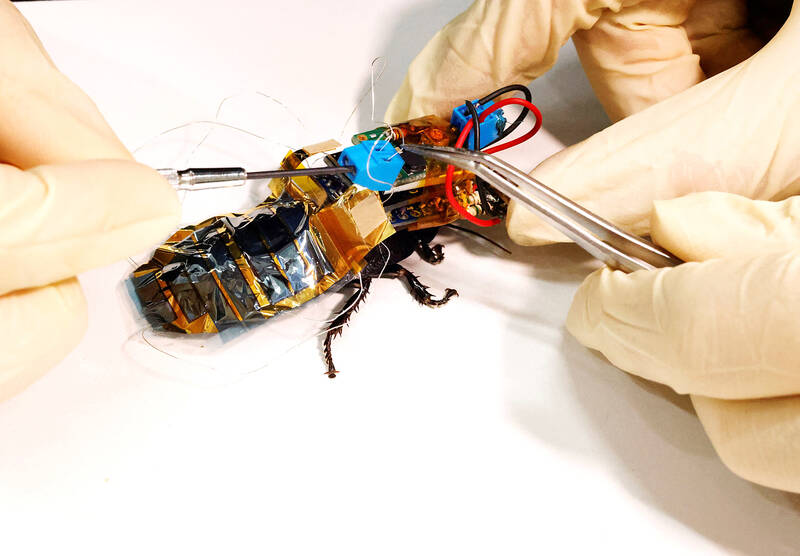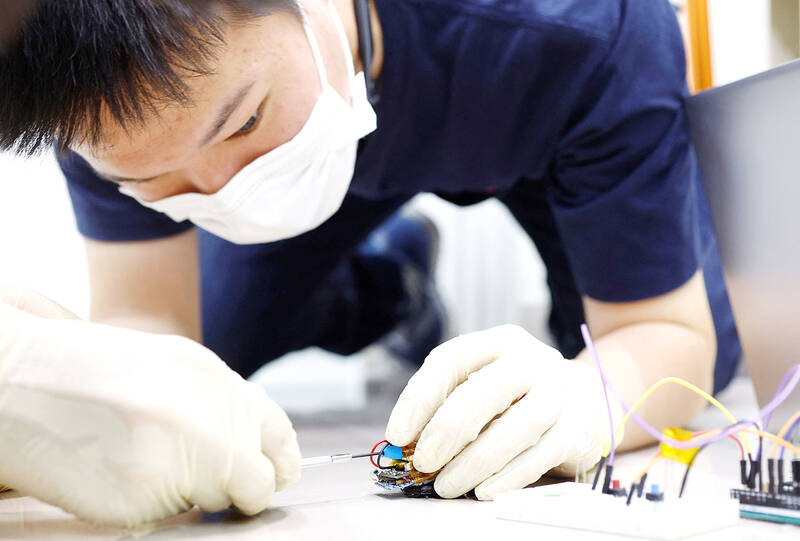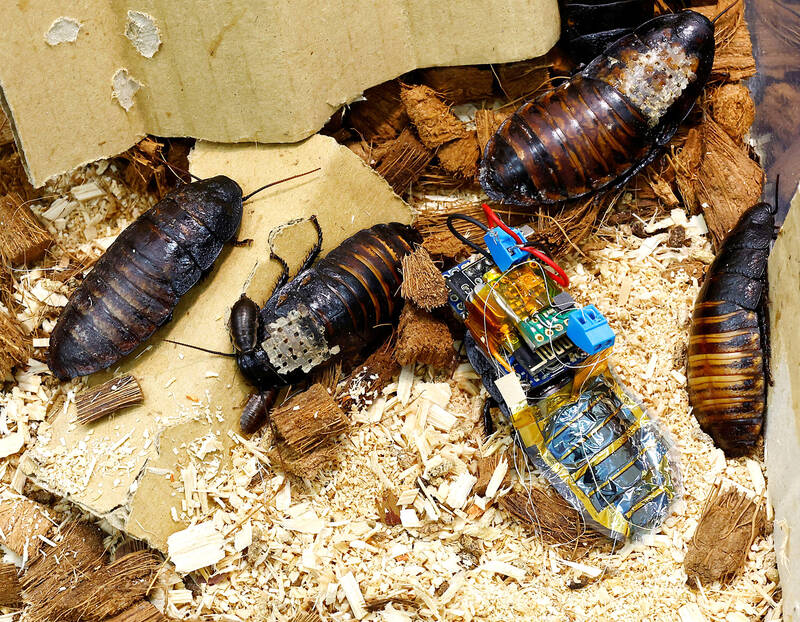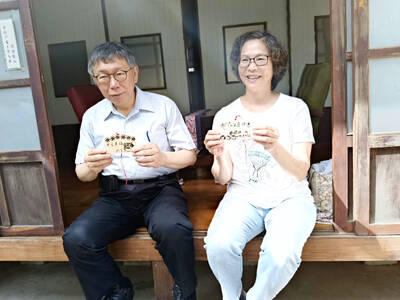If an earthquake strikes in the not too distant future and survivors are trapped under tonnes of rubble, the first responders to locate them could be swarms of cyborg cockroaches.
That’s a potential application of a recent breakthrough by Japanese researchers who demonstrated the ability to mount “backpacks” of solar cells and electronics on the bugs and control their motion by remote control.
Kenjiro Fukuda and his team at the Thin-Film Device Laboratory at Japanese research giant Riken developed a flexible solar cell film that’s 4 microns thick, about 1/25 the width of a human hair, and can fit on the insect’s abdomen.

Photo: Reuters
The film allows the roach to move freely while the solar cell generates enough power to process and send directional signals into sensory organs on the bug’s hindquarters.
The work builds upon previous insect-control experiments at Nanyang Technological University in Singapore and could one day result in cyborg insects that can enter hazardous areas much more efficiently than robots.
“The batteries inside small robots run out quickly, so the time for exploration becomes shorter,” Fukuda said. “A key benefit [of a cyborg insect] is that when it comes to an insect’s movements, the insect is causing itself to move, so the electricity required is nowhere near as much.”

Photo: Reuters
Fukuda and his team chose Madagascar hissing cockroaches for the experiments because they are big enough to carry the equipment and have no wings that would get in the way. Even when the backpack and film are glued to their backs, the bugs can traverse small obstacles or right themselves when flipped over.
The research still has a long way to go. In a recent demonstration, Riken researcher Yujiro Kakei used a specialized computer and wireless Bluetooth signal to tell the cyborg roach to turn left, causing it to scramble in that general direction. But when given the “right” signal, the bug turned in circles.
The next challenge is miniaturizing the components so that the insects can move more easily and to allow for mounting of sensors and even cameras. Kakei said he constructed the cyborg backpack with 5,000 yen (US$35) worth of parts purchased at Tokyo’s famed Akihabara electronics district.

Photo: Reuters
The backpack and film can be removed, allowing the roaches to go back to life in the lab’s terrarium. The insects mature in four months and have been known to live up to five years in captivity.
Beyond disaster rescue bugs, Fukuda sees broad applications for the solar cell film, composed of microscopic layers of plastic, silver, and gold. The film could be built into clothing or skin patches for use in monitoring vital signs.

Nine Taiwanese nervously stand on an observation platform at Tokyo’s Haneda International Airport. It’s 9:20am on March 27, 1968, and they are awaiting the arrival of Liu Wen-ching (柳文卿), who is about to be deported back to Taiwan where he faces possible execution for his independence activities. As he is removed from a minibus, a tenth activist, Dai Tian-chao (戴天昭), jumps out of his hiding place and attacks the immigration officials — the nine other activists in tow — while urging Liu to make a run for it. But he’s pinned to the ground. Amid the commotion, Liu tries to

A dozen excited 10-year-olds are bouncing in their chairs. The small classroom’s walls are lined with racks of wetsuits and water equipment, and decorated with posters of turtles. But the students’ eyes are trained on their teacher, Tseng Ching-ming, describing the currents and sea conditions at nearby Banana Bay, where they’ll soon be going. “Today you have one mission: to take off your equipment and float in the water,” he says. Some of the kids grin, nervously. They don’t know it, but the students from Kenting-Eluan elementary school on Taiwan’s southernmost point, are rare among their peers and predecessors. Despite most of

A pig’s head sits atop a shelf, tufts of blonde hair sprouting from its taut scalp. Opposite, its chalky, wrinkled heart glows red in a bubbling vat of liquid, locks of thick dark hair and teeth scattered below. A giant screen shows the pig draped in a hospital gown. Is it dead? A surgeon inserts human teeth implants, then hair implants — beautifying the horrifyingly human-like animal. Chang Chen-shen (張辰申) calls Incarnation Project: Deviation Lovers “a satirical self-criticism, a critique on the fact that throughout our lives we’ve been instilled with ideas and things that don’t belong to us.” Chang

The resignation of Taiwan People’s Party (TPP) co-founder Ko Wen-je (柯文哲) as party chair on Jan. 1 has led to an interesting battle between two leading party figures, Huang Kuo-chang (黃國昌) and Tsai Pi-ru (蔡壁如). For years the party has been a one-man show, but with Ko being held incommunicado while on trial for corruption, the new chair’s leadership could be make or break for the young party. Not only are the two very different in style, their backgrounds are very different. Tsai is a co-founder of the TPP and has been with Ko from the very beginning. Huang has